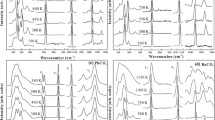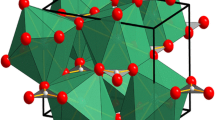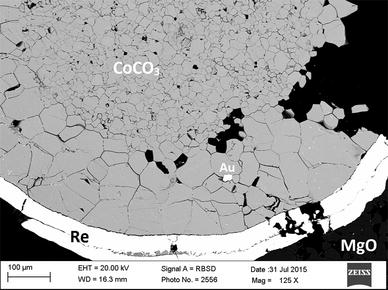Abstract
Raman spectra of magnesian phyllosilicates belonging to the serpentine, talc, and chlorite groups have been obtained at ambient conditions, and at high pressures and up to 200 °C in order to study high-pressure transformations in the 10 GPa range. The complex and distinct Raman spectra of these minerals allow straightforward identification, which may otherwise be difficult from optical microscopy. High-pressure measurements are in good agreement with DFT calculations for talc and lizardite. Pressure-induced displacive modifications are identified in lizardite and antigorite serpentines, and in chlorite at ~4, 7 and 8 GPa, respectively, while talc shows no transition up to ~11 GPa. At high temperature, the high-pressure distortions of serpentines shift to higher pressures. Given the stability limits of these minerals, and the natural range of P–T conditions, none of the high-pressure distortions observed at high pressure are likely to occur at depth in the Earth.






Similar content being viewed by others
References
Auzende AL, Daniel I, Reynard B, Lemaire C, Guyot F (2004) High-pressure behaviour of serpentine minerals: a Raman spectroscopic study. Phys Chem Miner 31:269–277
Balan E, Lazzeri M, Delattre S, Meheut M, Refson K, Winkler B (2007) Anharmonicity of inner-OH stretching modes in hydrous phyllosilicates: assessment from first-principles frozen-phonon calculations. Phys Chem Miner 34:621–625
Baroni S, de Gironcoli S, Dal Corso A, Giannozzi P (2001) Phonons and related crystal properties from density-functional perturbation theory. Rev Mod Phys 73:515–562
Bezacier L, Reynard B, Bass JD, Cardon H, Montagnac G (2013) High-pressure elasticity of serpentine, and seismic properties of the hydrated mantle wedge. J Geophys Res Solid Earth 118:1–9. doi:10.1002/jgrb.50076
Blaha JJ, Rosasco GJ (1978) Raman microprobe spectra of individuals microcrystals and fibers of talc, tremolite, and related silicate minerals. Anal Chem 50:892–896
Capitani GC, Stixrude L (2012) A first-principle investigation of antigorite up to 30 GPa: structural behavior under compression. Am Mineral 97:1177–1186. doi:10.2138/am.2012.3956
Caracas R, Bobocioiu E (2011) The WURM project-a freely available web-based repository of computed physical data for minerals. Am Mineral 96:437–443
Chervin JC, Canny B, Besson JM, Pruzan P (1995) A diamond anvil cell for IR microspectroscopy. Rev Sci Instrum 66:2595–2598
Dawson P, Hadfield CD, Wilikinson GR (1973) The polarized infrared and Raman spectra of Mg(OH)2 and Ca(OH)2. J Phys Chem Solids 34:1217–1225
Ehlmann BL, Mustard JF, Swayze GA, Clark RN, Bishop JL, Poulet F, Marais DJD, Roach LH, Milliken RE, Wray JJ, Barnouin-Jha O, Murchie SL (2009) Identification of hydrated silicate minerals on Mars using MRO-CRISM: geologic context near Nili Fossae and implications for aqueous alteration. J Geophys Res Planets. doi:10.1029/2009je003339
Etiope G, Schoell M, Hosgormez H (2011) Abiotic methane flux from the Chimaera seep and Tekirova ophiolites (Turkey): understanding gas exhalation from low temperature serpentinization and implications for Mars. Earth Planet Sci Lett 310:96–104. doi:10.1016/j.epsl.2011.08.001
Früh-Green GL, Connolly JAD, Plas A, Kelley DS, Grobety B (2004) Serpentinization of oceanic peridotites: implications for geochemical cycles and biological activity. In: Wilcock WSD, DeLong EF, Kelley DS, Baross JA, Cary SC (eds) Subseafloor Biosphere at Mid-Ocean Ranges, vol 144. AGU, Washington DC, pp 119–136
Gatta GD, Merlini M, Valdrè G, Liermann H-P, Nénert G, Rothkirch A, Kahlenberg V, Pavese A (2013) On the crystal structure and compressional behavior of talc: a mineral of interest in petrology and material science. Phys Chem Miner 40:145–156. doi:10.1007/s00269-012-0554-4
Goffe B, Michard A, Kienast JR, Le Mer O (1988) A case of abduction-related high-pressure, low-temperature metamorphism in upper crustal nappes, Arabian continental margin, Oman: P–T paths and kinematic interpretation. Tectonophysics 151:363–386
Gonze X, Beuken JM, Caracas R, Detraux F, Fuchs M, Rignanese GM, Sindic L, Verstraete M, Zerah G, Jollet F, Torrent M, Roy A, Mikami M, Ghosez P, Raty JY, Allan DC (2002) First-principles computation of material properties: the ABINIT software project. Comput Mater Sci 25:478–492. http://www.abinit.org
Gonze X, Rignanese GM, Caracas R (2005) First-principle studies of the lattice dynamics of crystals, and related properties. Z Fur Krist 220:458–472
Hilairet N, Daniel I, Reynard B (2006a) Equation of state of antigorite, stability field of serpentines, and seismicity in subduction zones. Geophys Res Lett 33:L02302
Hilairet N, Daniel I, Reynard B (2006b) P–V equations of state and the relative stabilities of serpentine varieties. Phys Chem Miner 33:629–637
Hilairet N, Reynard B, Wang YB, Daniel I, Merkel S, Nishiyama N, Petitgirard S (2007) High-pressure creep of serpentine, interseismic deformation, and initiation of subduction. Science 318:1910–1913. doi:10.1126/science.1148494
Hyndman RD, Peacock SM (2003) Serpentinization of the forearc mantle. Earth Planet Sci Lett 212:417–432
Kawano S, Katayama I, Okazaki K (2011) Permeability anisotropy of serpentinite and fluid pathways in a subduction zone. Geology 39:939–942. doi:10.1130/g32173.1
Kelley DS, Karson JA, Blackman DK, Fruh-Green GL, Butterfield DA, Lilley MD, Olson EJ, Schrenk MO, Roe KK, Lebon GT, Rivizzigno P, Party ATS (2001) An off-axis hydrothermal vent field near the Mid-Atlantic Ridge at 30 degrees N. Nature 412:145–149. doi:10.1038/35084000
Kleppe AK, Jephcoat AP, Welch MD (2003) The effect of pressure upon hydrogen bonding in chlorite: a Raman spectroscopic study of clinochlore to 26.5 GPa. Am Mineral 88:567–573
Kloprogge JT, Frost RL, Rintoul L (1999) Single crystal Raman microscopic study of the asbestos mineral chrysotile. Phys Chem Chem Phys 1:2559–2564
Lazarev A (1972) Vibrational spectra and structure of silicates. Consultants Bureau, New York
Mao H, Xu J, Bell P (1986) Calibration of the ruby pressure gauge to 800 kbar under quasi-hydrostatic conditions. J Geophys Res 91:4763–4767
Mellini M, Viti C (1994) Crystal structure of lizardite-1T from Elba, Italy. Am Mineral 79:1194–1198
Mookherjee M, Stixrude L (2009) Structure and elasticity of serpentine at high-pressure. Earth Planet Sci Lett 279:11–19. doi:10.1016/j.epsl.2008.12.018
Nestola F, Angel RJ, Zhao J, Garrido CJ, Sanchez-Vizcaino VL, Capitani G, Mellini M (2010) Antigorite equation of state and anomalous softening at 6 GPa: an in situ single-crystal X-ray diffraction study. Contrib Mineral Petrol 160:33–43. doi:10.1007/s00410-009-0463-9
Padron-Navarta JA, Sanchez-Vizcaino VL, Hermann J, Connolly JAD, Garrido CJ, Gomez-Pugnaire MT, Marchesi C (2013) Tschermak’s substitution in antigorite and consequences for phase relations and water liberation in high-grade serpentinites. Lithos. doi:10.1016/j.lithos.2013.02.001
Payne M, Teter M, Allan DC, Arias TA, Joannopoulos J (1992) Iterative minimization techniques for ab initio total-energy calculations, molecular dynamics and conjugate gradients. Rev Mod Phys 64:1045–1097
Pons M, Quitté G, Fujii T, Rosing M, Reynard B, Moynier F, Douchet C, Albarède F (2011) Early Archean serpentine mud volcanoes at Isua, Greenland, as a niche for early life. Proc Natl Acad Sci 108:17639–17643. doi:10.1073/pnas.1108061108
Prieto A, Dubessy J, Cathelineau M (1991) Structure–composition relationships in trioctahedral chlorites: a vibrational spectroscopic study. Clays Clay Miner 39:531–539
Reynard B (2013) Serpentine in active subduction zones. Lithos 178:171–185. doi:10.1016/j.lithos.2012.10.012
Reynard B, Caracas R (2009) D/H isotopic fractionation between brucite Mg(OH)2 and water from first-principles vibrational modeling. Chem Geol 262:159–168
Reynard B, Wunder B (2006) High-pressure behavior of synthetic antigorite in the MgO–SiO2–H2O system from Raman spectroscopy. Am Mineral 91:459–462
Reynard B, Mibe K, Van de Moortele B (2011) Electrical conductivity of the serpentinised mantle and fluid flow in subduction zones. Earth Planet Sci Lett 307:387–394. doi:10.1016/j.epsl.2011.05.013
Reynard B, Montagnac G, Cardon H (2012) Raman spectroscopy at high pressure and temperature for the study of the Earth’s mantle and planetary materials. In: EMU Notes in Mineralogy, vol 12. EMU and Mineralogical Society, Twickenham, pp 365–388
Rüpke LH, Morgan JP, Hort M, Connolly JAD (2004) Serpentine and the subduction zone water cycle. Earth Planet Sci Lett 223:17–34. doi:10.1016/j.epsl.2004.04.018
Schulte M, Blake D, Hoehler T, McCollom T (2006) Serpentinization and its implications for life on the early Earth and Mars. Astrobiology 6:364–376. doi:10.1089/ast.2006.6.364
Schwartz S, Guillot S, Reynard B, Lafay R, Debret B, Nicollet C, Lanari P, Auzende AL (2013) Pressure–temperature estimates of the lizardite/antigorite transition in high pressure serpentinites. Lithos 178:197–210. doi:10.1016/j.lithos.2012.11.023
Simon G, Chopin C, Schenk V (1997) Near-end-member magnesiochloritoid in prograde-zoned pyrope, Dora-Maira massif, western Alps. Lithos 41:37–57
Syracuse EM, van Keken PE, Abers GA (2010) The global range of subduction zone thermal models. Phys Earth Planet Inter 183:73–90. doi:10.1016/j.pepi.2010.02.004
Tsuchiya J (2013) A first-principles calculation of the elastic and vibrational anomalies of lizardite under pressure. Am Mineral 98:2046–2052. doi:10.2138/am.2013.4369
Ulmer P, Trommsdorff V (1995) Serpentine stability to mantle depths and subduction-related magmatism. Science 268:858–861
Veithen M, Gonze X, Ghosez P (2005) Nonlinear optical susceptibilities, Raman efficiencies, and electro-optic tensors from first-principles density functional perturbation theory. Phys Rev B 71:1–14
Velde B (1980) Ordering in synthetic aluminous serpentines: infrared spectra and cell dimensions. Phys Chem Miner 6:209–220
Welch MD, Crichton WA (2005) A high-pressure polytypic transformation in type-I chlorite. Am Mineral 90:1139–1145. doi:10.2138/am.2005.1756
Welch MD, Kleppe AK, Jephcoat AP (2004) Novel high-pressure behavior in chlorite: a synchrotron XRD study of clinochlore to 27 GPa. Am Mineral 89:1337–1340
Zhang JS, Reynard B, Montagnac G, Bass JD (2014) Pressure-induced Pbca–P2 1 /c phase transition of natural orthoenstatite: the effect of high temperature and its geophysical implications. Phys Earth Planet Inter. doi:10.1016/j.pepi.2013.09.008
Acknowledgments
This work was supported by INSU through the national Raman facility in Lyon, and “Programme National de Planétologie.” It is a contribution of the LABEX Lyon Institute of Origins (ANR-10-LABX-0066), within the program “Investissements d’Avenir” (ANR-11-IDEX-0007) at Université de Lyon. Calculations were performed at the PSMN center of ENS Lyon and on the Jade machine of CINES under computational grant stl2816. Richard Sedlock guided sample collection in Baja California. Joerg Hermann kindly provided the Saas-Zermatt chlorite, Marco Mellini the Elba lizardite, Stéphane Guillot the antigorite from Cuba, Ichiko Shimizu the Oeyama sample, Francis Albarède the talc from Isua, and Bruno Goffé the sudoite from Oman and clinochlore from Dora Maira. Mark Welch and an anonymous reviewer are thanked for thoughtful suggestions.
Author information
Authors and Affiliations
Corresponding author
Electronic supplementary material
Below is the link to the electronic supplementary material.
Rights and permissions
About this article
Cite this article
Reynard, B., Bezacier, L. & Caracas, R. Serpentines, talc, chlorites, and their high-pressure phase transitions: a Raman spectroscopic study. Phys Chem Minerals 42, 641–649 (2015). https://doi.org/10.1007/s00269-015-0750-0
Received:
Accepted:
Published:
Issue Date:
DOI: https://doi.org/10.1007/s00269-015-0750-0




